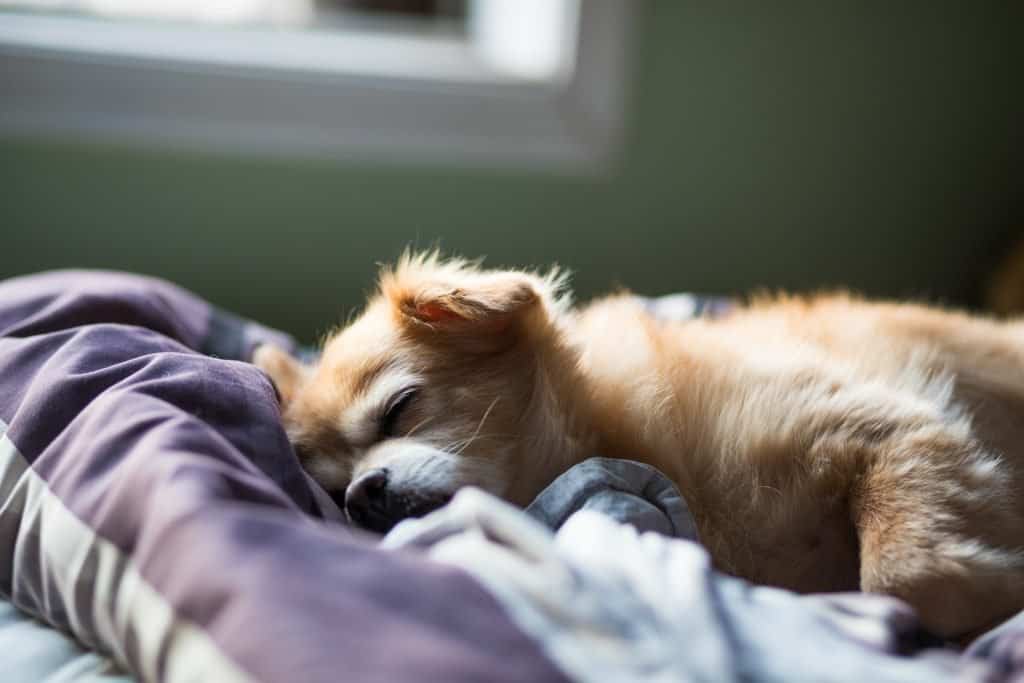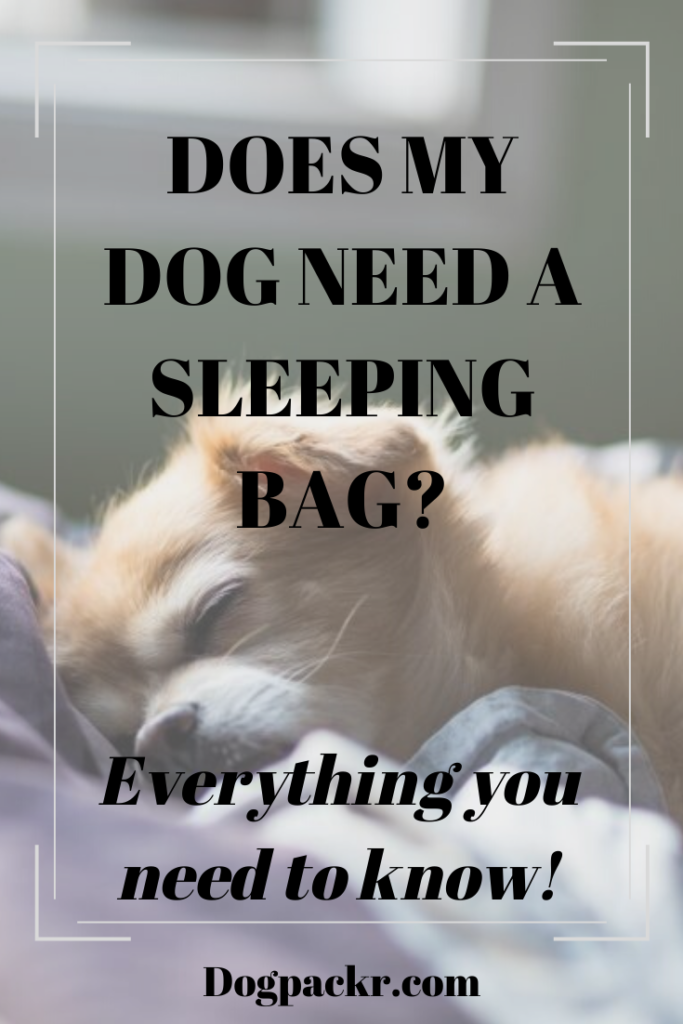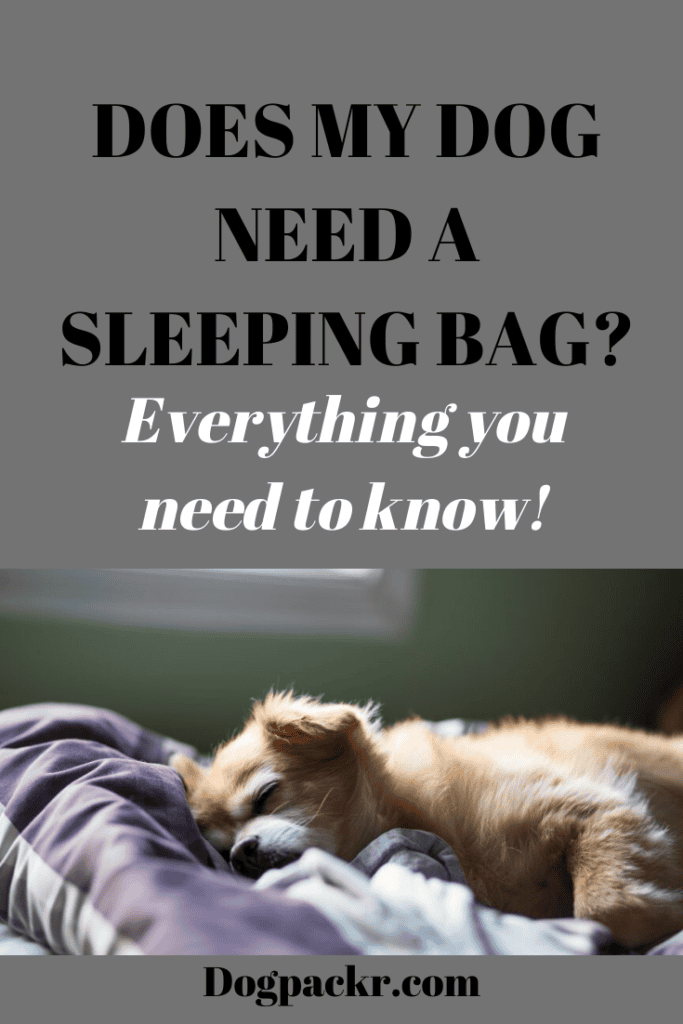
Camping with your little pupper can be so much fun. There’s nothing better than sleeping in nature. Especially if you can go wild camping, you can stop at the nicest places and put up your tent, just lovely. Also, a good mattress and sleeping bag can keep you warm even if the outside temperatures drop at night.
But what about your dog? Does he also need a sleeping bag to stay warm or is he fine just with his coat?
The answer is: it depends… Very helpful so far, right? 😉
No, seriously, it really depends on your dog. Some dogs are shivering at 45° F (7.2° C). In this case, a doggie sleeping bag is a very good idea. Because the other option is that you will have to share your sleeping bag with your furry love. If you ever had to share your sleeping bag, you know that this is not very pleasant way to sleep.
Some other dogs can’t stand to even be covered with a blanket (like Baloo) because they just get hot very quickly.
If you sleep at temperatures below 32° F (0° C) a doggie sleeping bag is highly recommended in any case, though.
You wanna buy a dog sleeping bag but aren’t quite sure which one you should get? Check out my other post about the 3 best sleeping bags for small dogs.
Table of Contents
Why a sleeping bag?
First and most important, dogs look sooo cute in sleeping bags 😉 I sometimes wish that Baloo would like it to be covered just because it’s so sweet.
But secondly, it’s also important to keep your pooch safe at night. While a blanket might also do the job, a sleeping bag is probably the better option. Most dogs love to curl up in things. It makes them feel cozy and safe. Also, a sleeping bag can provide much more warmth than a blanket.
Protection
Just as humans, dogs have to maintain a certain body temperature to survive. If it gets really cold at night, they might not be able to regulate their body temperature themselves. Even though most dogs have a dense undercoat which can keep them warm even at low temperatures, it might not be enough at night.
Body temperature
While our body temperature ranges from 97.6 to 99.6° F (36.4 to 37.5° C), your pup’s body temperature is slightly higher, ranging from 101 to 102.5° F (38.3 to 39.2° C). If a dog’s body temperature drops to 95 to 99° F (37.2 to 35° C), he risks to be in a state of Hypothermia.

Factors to determine your dog’s cold tolerance
Here’s an overview of the factors that make one dog more cold tolerant than another (source). These factors are responsible for the way in which a dog responds to cold:
- Coat type: some dogs have 2 thick layers of coat. The undercoat protects them from wind and weather. Most dogs with long fur have two layers. It also depends on the thickness of their fur. A Siberian Husky, e.g., has two very thick layers of coat. A Golden Retriever has thinner fur but still two layers. But there are also short-haired dogs with double-layer coat, such as Rottweilers. Single-coated dogs don’t have an undercoat. These are the kind of dogs that are often referred to as non-shedding (technically they still shed but their hair growth cycle is much longer which makes them seem to be non-shedding). Examples are Poodles, Maltesers or Bichon Frise. They lack one layer of coat. Hence they get cold quicker than double-coated dogs.
- Coat color: a dark colored coat absorbs the heat of the sun better, hence keeps the dog warmer.
- Size: Small dogs tend to lose body heat more easily. More to that in a second.
- Weight: body fat acts as an insulator. Many small dogs have less body fat than their bigger counterparts.
- Conditioning: dogs who are used to cold temperature will support it more easily than dogs that are used to warmer weather.
- Age and Health: puppies and older dogs tend to get cold more quickly than healthy young dogs.
How cold can a small dog tolerate?
Small dogs tend to be cold quicker than their bigger siblings. Small dogs have shorter legs which puts their body closer to the cold ground. Especially in snow this can be an issue as they have to wade through it with half of their body sinking into the snow. This can also be really draining for them. Further, small dogs have a larger surface area to volume ratio. Their skin is bigger in relation to their intestines. This means that they have to heat a bigger area.
Generally, temperatures until 45° F (7.2° C) shouldn’t be an issue for most dogs. Dogs who are very sensitive to cold will probably start to feel cold if the temperature drops below 32° F (0° C). But these numbers are indicators for your dog during the day when he’s moving. At night, many small dogs will probably already feel cold at 45° F (7.2° C). If the temperature drops below 32° F (0° C) you should definitely have something to keep your pooch warm, such as a sleeping bag.

How to tell if my dog is cold
A very clear sign is if your pup shivers or trembles. Also, if he’s keeping his tail close to his body. Then he is definitely freezing. Also a good way to find out if your pooch is cold is to feel his ears. If they feel cold, he is most likely cold in general.
Watch your pup’s behavior. If he’s moving slowly, hiding behind you or under objects, he’s likely cold, too. In your tent he might be trying to crawl under your sleeping bag or cuddle close to you. In this case it’s a good idea to give your doggo his own sleeping bag.
Sleeping bag kinds
Now that you know for what kind of dog and which situation a sleeping bag is a good idea, the next question is: which one should I chose?
There are 5 different kinds of sleeping bags for dogs:
- The Cup: actually looking like a cup, that’s the perfect choice for a curler.
- The Cave: this one is created to mimic ancient dog sleeping styles. Wild dogs would usually dig some kind of cave for themselves to lie inside and find shelter.
- The Pod: similar to the cup but more plush. Also good for very sensitive curlers.
- The Flat: looking most like a traditional people sleeping bag, your dog can stretch or curl in it as he likes.
- The Bed Style: a very simple form consisting of basically just a bed and a cover.
Make sure to check out my other post about the 3 best sleeping bags for small dogs.
How to teach your dog to sleep in his sleeping bag
Just as with every new piece of gear, you have to slowly accustom your pooch to the new thing. For most dogs this shouldn’t be an issue as they love to snuggle into something. Also, you don’t have to close it on top of his head like a carrier. So there shouldn’t be any stress factor for your pup. However, it’s still important to let your dog get used to it at home.
Just put the sleeping bag in his regular sleeping place. Usually, he will sleep on it after a short while. If he doesn’t want to sleep on or in it, put some treats inside.
Generally, it will probably just take your pupper some time to get to know it. But it really shouldn’t be a big issue. Once he knows it, he will happily go inside during a cold camping night.
If your dog is the hot kind
I’ve taken Baloo on numerous camping trips (such as in Switzerland) and we both really enjoy it. Until now, we have only been camping during the warmer seasons of the year. So the temperature never dropped below about 45° F (7.2° C). In those cases I like to make it as easy as possible. On our first trip, I forgot his blanket where he usually sleeps on when we’re on a trip. So I just put my down jacket in a corner and told him to sleep there. He happily curled up on it and didn’t seem to be cold at all. Even if your pup doesn’t want a sleeping bag, he should always have something to lie on. The cold that comes from the ground can’t be underestimated. So either bring his blanket or for colder nights a mattress.
Baloo is a miniature Poodle so I actually expected him to be cold much quicker. But no, he hates to be covered and gets hot only by lying on my lap.
So, it really depends…
*Disclosure: This post may contain affiliate links, meaning, I get a commission if you decide to make a purchase through one of my links, at no cost to you.

